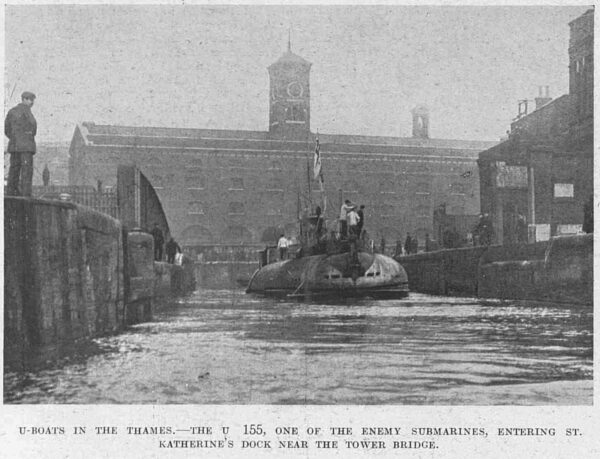One hundred years ago, four German submarines slipped through Tower Bridge and into the Port of London, heart of the city’s cargo trade.

Eerste Wereldoorlog. Zeeoorlog. 1918. Overgave / uitlevering van de Duitse vloot aan de Engelsen: eerste Duitse U-boot voor de London Towerbridge. Engeland, Londen, 1918.
They were fortunately not on an attack mission, as the war had ended the previous month, and these four submarines were now the spoils of war.
As part of the Armistice agreement, German submarines had to surrender to the British, and by December over 120 submarines had surrendered at the agreed point, off the coast of Harwich.
Several were then dispatched, with British sailors to various ports around the UK as propaganda about the end of the war.
Of the four heading to London, the most famous was the U-155 Deutschland, which was the first to make a trans-Atlantic crossing, and was originally designed as a new generation of cargo carrier that could slip past Allied blockades of German ports.
After making two voyages as an unarmed merchantman, she was taken over by the German Imperial Navy in February 1917 and converted into U-155, armed with six torpedo tubes and two deck guns. As U-155, she began a raiding career in June 1917 that was to last until October 1918, sinking 120,434 tons of shipping and damaging a further 9,080 tons of shipping.
However, post-war reports by British newspapers were pretty scathing about the submarine, noting that British submarines were (obviously) superior.
The four U-Boats left Harwich for London on 2nd December 1918, arriving the following afternoon – 100 years ago today.
The U-155 turned back to St Katherine Dock, while two more headed up towards Westminster, the mine-layer, UB6 and German Navy’s most advanced submarine, the UC95. The other U-Boat, U-152 headed out to Greenwich and was moored up along the pier there.
They were all for public display, and people could pay a shilling to go on board for a look around.
The U-155 was moored up in St Katherine’s Dock next to the Q-Boat, HMS Suffolk Coast, a disguised cargo ship with heavy guns hidden below deck, and used during the war to lure German submarines in for what they thought would be an easy kill of an unarmed boat.
Most of the U-Boats were scuttled or sold for scrap, while U-155 was sold to a company controlled by Horatio Bottomley MP who planned to send it around the UK for exhibitions.
The exhibitions were a financial disaster though, with a loss of £15,000, and in September 1921, the ship was taken to be broken up at Birkenhead. Sadly, during scrapping, there was an explosion and five young fitter’s apprentices were killed. Bottomley himself was later convicted of an unrelated fraud, and spent 7 years in jail, dying in 1933 in poverty.
But, for a few weeks, there were four German submarines in London, and what a sight it was to the war weary public.
Sources:
Daily Mirror – Monday 02 December 1918
Sheffield Independent – Tuesday 03 December 191
Daily Mirror – Wednesday 04 December 1918
The Sphere – Saturday 14 December 1918









Never heard of this before, very interesting Ian. Thanks for sharing.
Interesting indeed. I knew about Operation Deadlight, the equivalent in WW2:
https://en.wikipedia.org/wiki/Operation_Deadlight